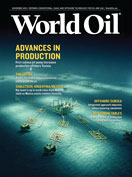Issue: November 2015
Special Focus
The successful installation and operation of the industry’s first subsea jet pump has allowed wells offshore Tunisia to produce well above the expected rate, which makes future consideration for this type of application even more likely.
The industry has moved increasingly toward highly deviated, horizontal well designs, although pumping systems lag in technical advancement. An equipment suite has been developed to address the challenges that new well designs create for traditional artificial lift systems.
Features
Enabled by the integration of a process-simulation tool and a transient, multiphase, pipe-flow simulator, an accurate simulation of the boosting station and its flowlines, within a single model, allows the capturing of key interactions between the processing equipment, the well, and flow conditions in the pipeline and riser.
The North American rig fleet decreases, as a large portion of idle rigs is taken out of commission. The global offshore mobile fleet has leveled off.
Prices, sanctions and environmental politics chill the air
For nearly 100 years, the National Research Council of Canada (NRC) has built a reputation as a results-focused R&D performer, capable of adapting to meet the most critical challenges.
Conditions in the Barents Sea are more favorable for offshore activities than in other Arctic areas.
Prime reserves, but widely different near-term prospects
Columns
Stop it—stop drilling, producing or storing
A reason to smile
Price does matter
The new cutting—coping paradigm
Now hear this
Shell’s idealistic Arctic adventure
China vs. Japan E&P dispute now militarized
Increased eCommerce adoption yields benefits
Mark Plummer: Entrepreneur and self-made man
Exposé paints unflattering picture of Venezuelan oil and gas sector
News & Resources
World of oil and gas
Industry at a glance
People in the industry
New products and services
Companies in the news
ShaleTech Report
The shale oil E&P sector is entering the second year of low crude oil prices.
An enhanced P110 grade for horizontal drilling extends operational efficiencies and mitigates risk.
While no two refracturing treatments are identical, results from pilot wells demonstrated that using a collaborative workflow can help to consistently and repeatedly recover bypassed reserves at a lower cost per BOE, compared to the development costs for new drills.
A water-reducing proppant, utilizing unique resin chemistry, is able to maintain oil and gas output.
The inability of reservoir models to realistically simulate fractures compromises their accuracy. However, a new method offers operators the ability to accurately forecast well production and reservoir drainage for nearby wells.
Drilling horizontal Montney wells in British Columbia has been historically troublesome and notoriously slow. An initiative to optimize ROP by adapting predictive modeling to MPD technology has succeeded.
World Oil Awards
The 2015 World Oil Awards honored those “Charting a Path to the Future” in the oil and gas industry.



